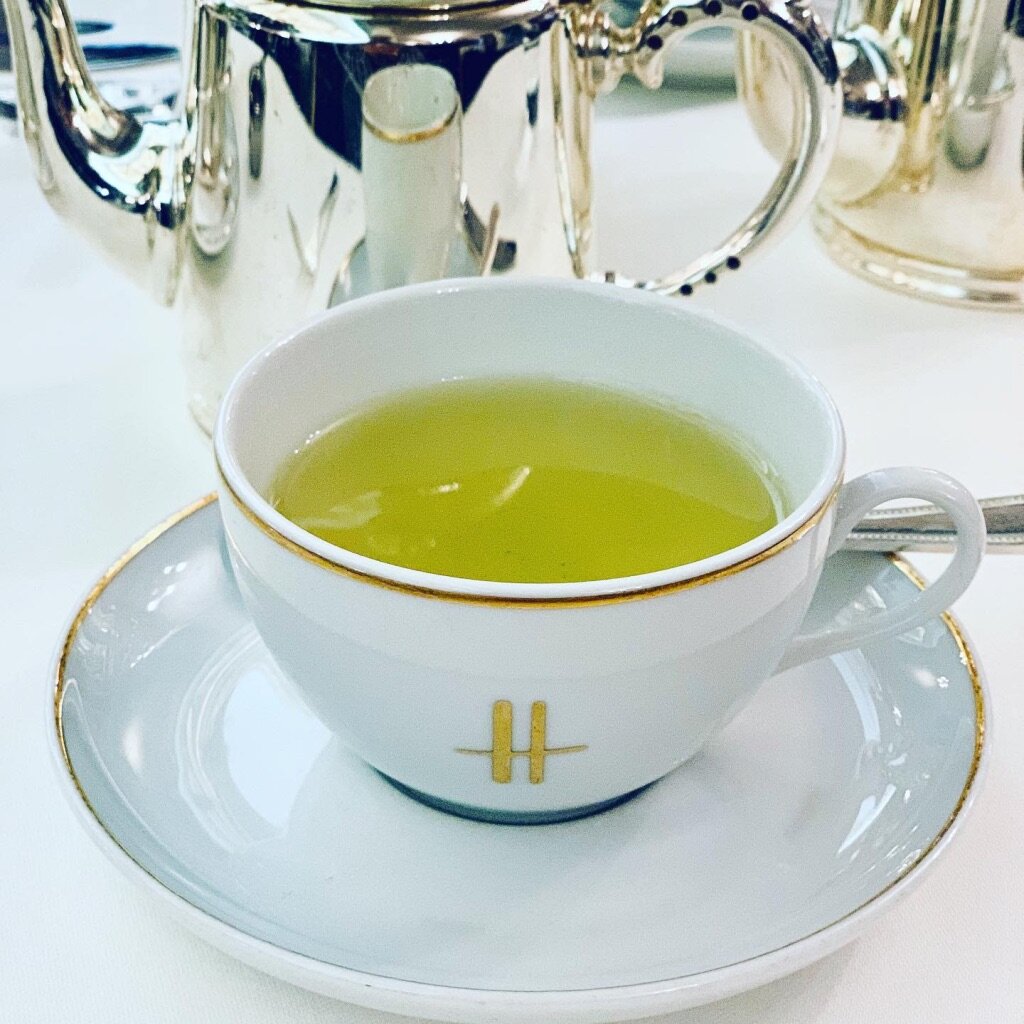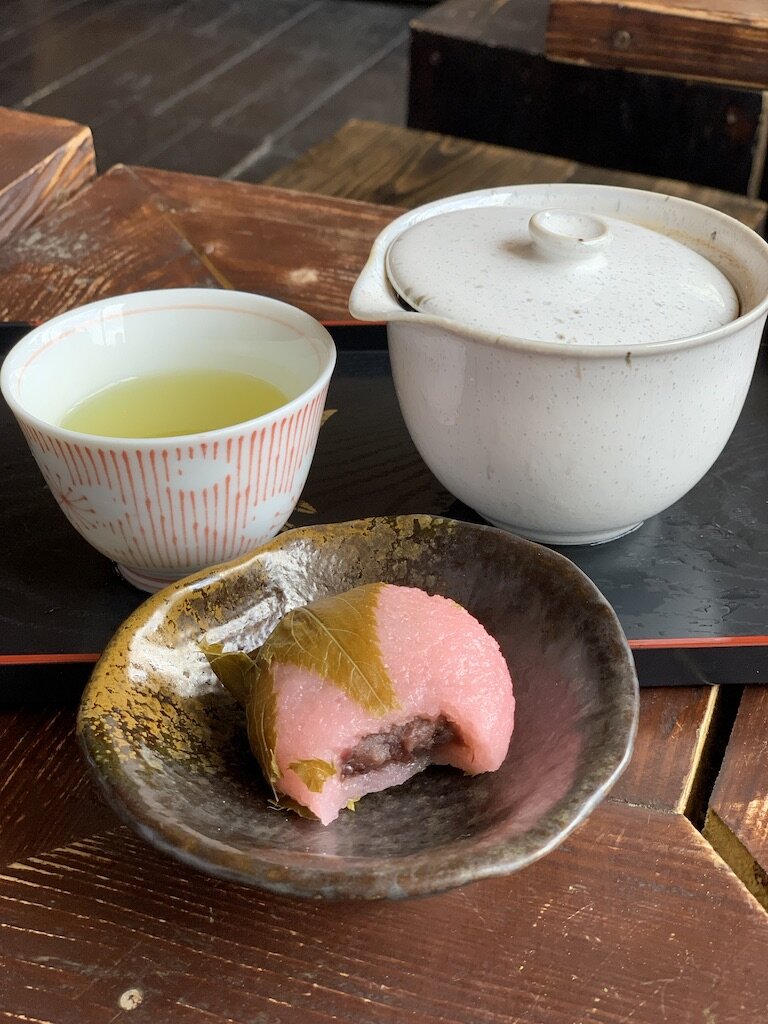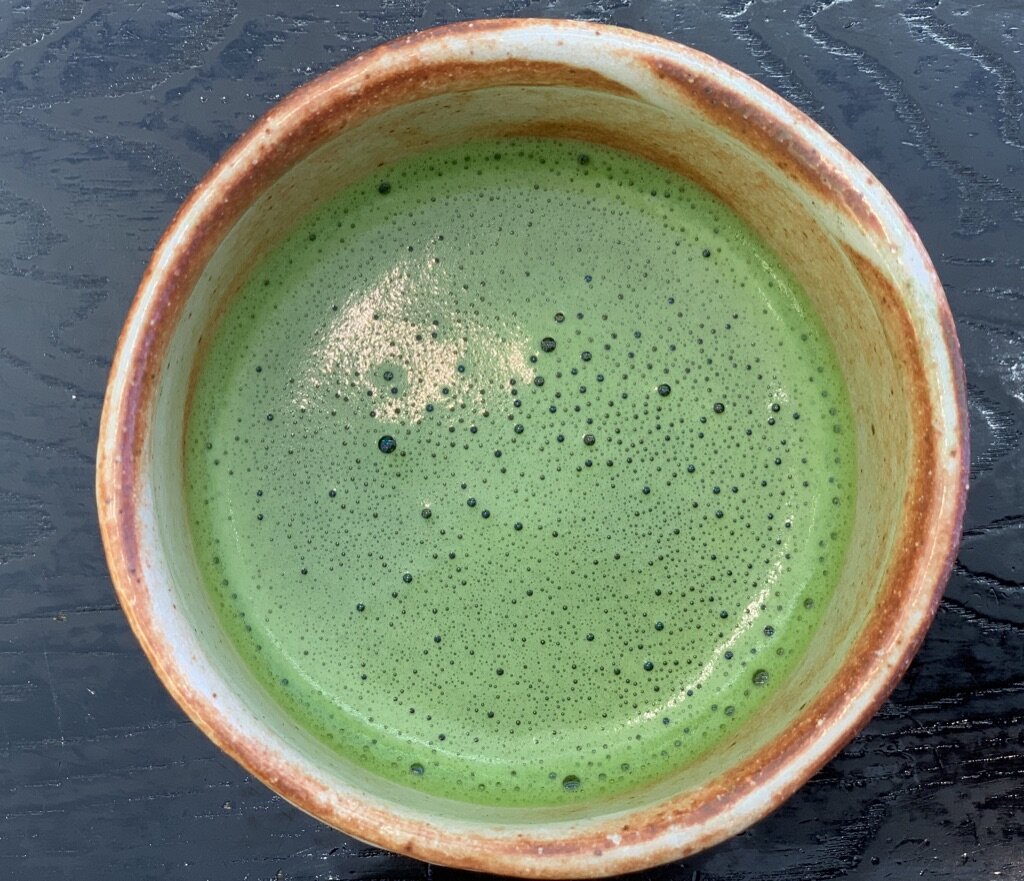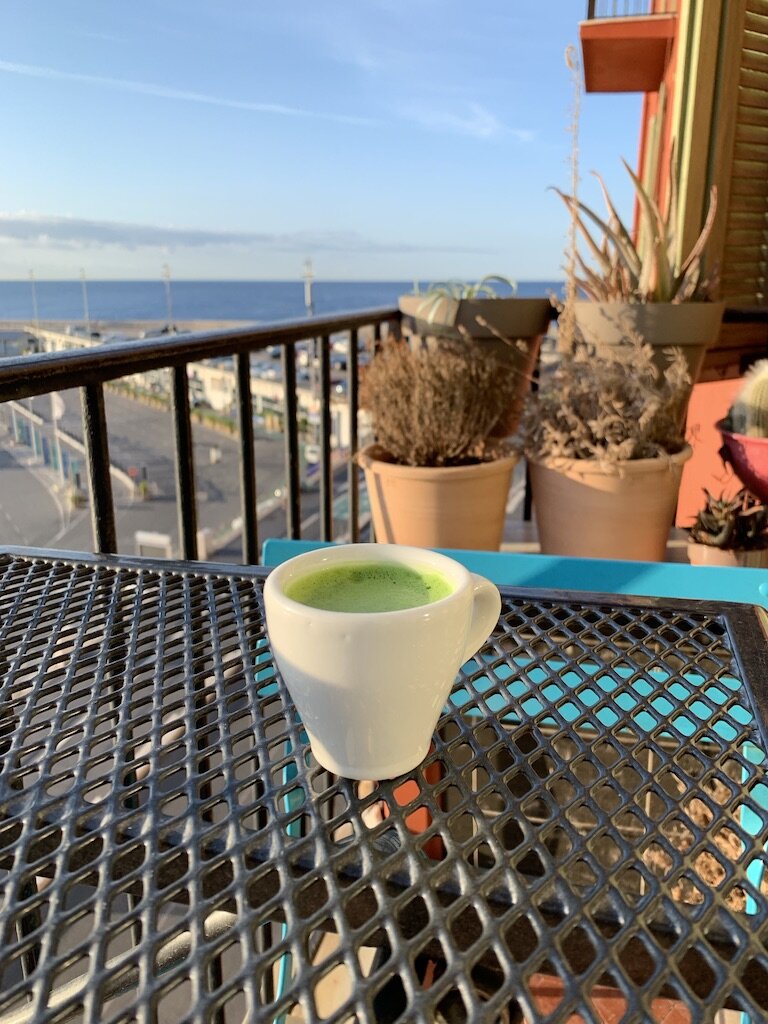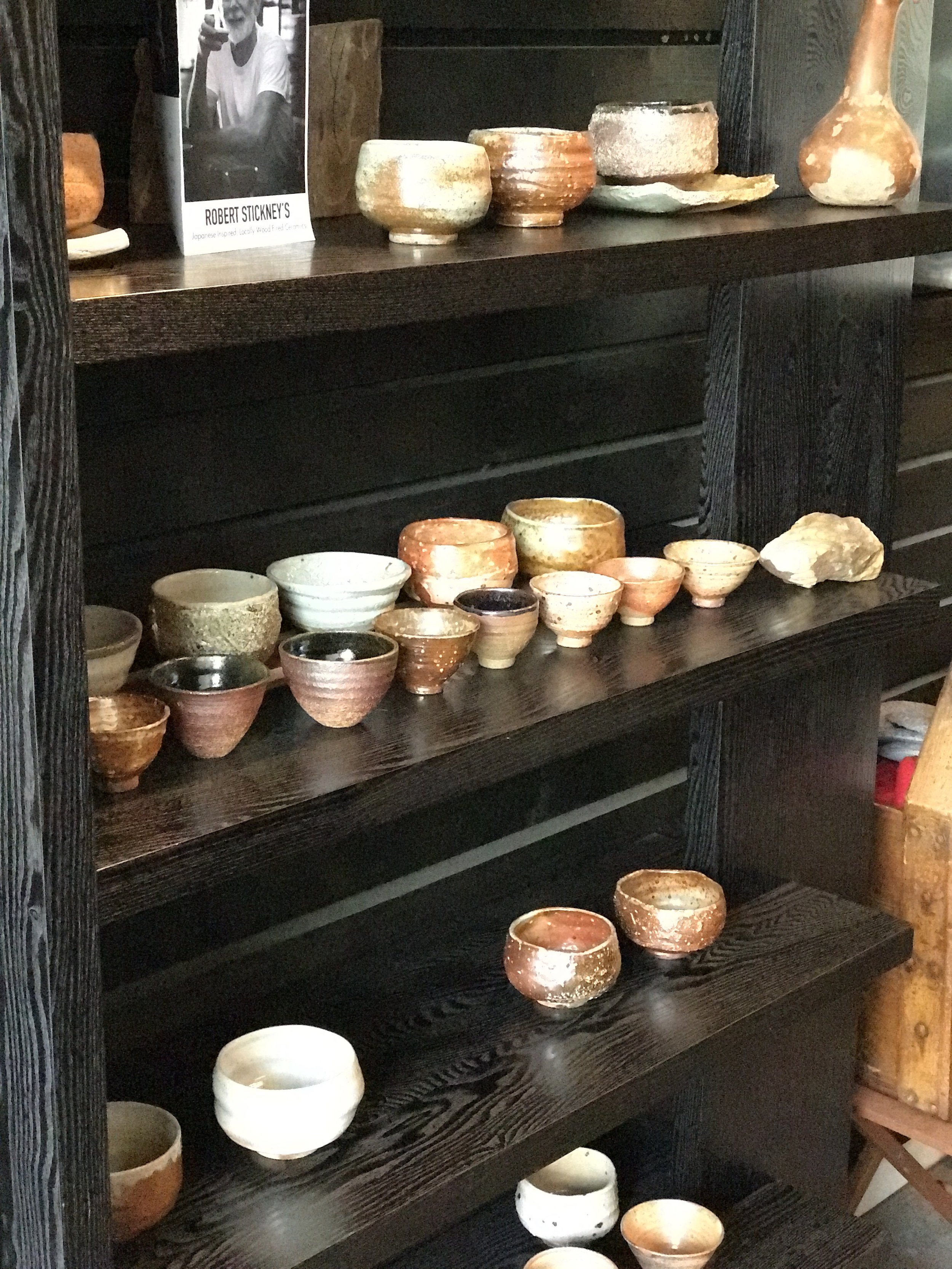
Matcha Travels through London and Nice
This year my trip around the globe took me to London and to Nice! Such an amazing trip, yet a tug of war arises within that leaves me deeply struggling to reconcile the two sides - the one side of me that LOVES travel, seeing new places, experiencing new cultures, discovering new teahouses in which to sip an afternoon away, and the socially, environmentally conscious side that knows I am contributing to climate change no matter how may carbon credits to offset my footprint I purchase. Meditating on my personal and direct impact leaves me questioning and searching.
I was only in London for a few days, so I had to pack as much matcha tasting in as possible, given that I had other plans in the city. Prior to landing, I received only a few suggestions from some of my matcha loving friends on social media of places to visit. London is not the first place you think of visiting for Japanese teas. Had I longed for traditional English high tea, my cup would have runneth over. However, London is the home of one of my first matcha loves - the Matchaeologist. While they do not have a physical store, several of their products are stocked by specialist tea and coffee shops throughout London (like WA Cafe, a small, independent Japanese patisserie making Japanese breads and pastries daily on-site in their Covent Gardens location). Before my departure, I messaged the Matchaeologist and they shared how they often provide free next-day shipping to UK hotels. I was so tempted, but I was already traveling with my stash of their matcha, and I anticipated purchasing new brands during my travels, which I did.
We arrived at 8 AM in Trafalgar Square, dropped off our bags at our hotel, and headed to the TKTS booth to get tickets for a show that evening. Along the way we passed Japan Center and stopped in for a quick matcha latte with soy milk, which was unremarkable, before standing in line. Later that evening, before the show, I stopped into Tsujiri at their Soho location. Sadly I didn’t get to stop at their other location. This storefront lacked the elegance and aesthetic evident in the photos of the their other locations. Most of the patrons that evening were partaking in all the matcha-flavored, dairy delights, but alas, as a dairy-free, gluten-free person, I cannot. However, I was able to get a hardy chawan of matcha and a vegan, Houjicha-flavored dark chocolate bar. I was a tad disappointed, despite it being their higher tier matcha. I find found it a bit flat and bitter with a bit of a stale smell. Still, it was my first official chawan in London. The chocolate bar was fantastic and did not make it until intermission, which was my intention.
Before my spa and massage at the wonderful Corinthia Hotel London, I managed to grab a spot of breakfast accompanied by a very creamy, smooth and delicious, although a tad sweet, almond milk matcha latte. I must say, I fancied the glass cups in which these were served.
Later that evening, we popped over to Harrod’s, mostly to see the whole spectacle of the establishment. The gyokuro I had was a beautiful color, but the temperature of the water was a bit too hot and perhaps steeped a few seconds too long. Still the presentation was lovely, and I thoroughly enjoyed seeing all the people sipping tea and just taking some leisure time to chat and relax over a cup of tea.
Then I found Katsute100 and I was in heaven. Walking in I knew I found a place I could settled in for a cozy late morning, just taking my time to taste the matcha, teas and Japanese delicacies. Just as the website says, time moves slowly here and I felt unhurried and peaceful. Had I been without a schedule, I would have spent several more hours than I had, drinking tea and writing in the table in the front seating area, looking out the window at the people walking by. The smaller sitting area in the back room feels even more cozy and intimate.
Not only was their limited Heritage matcha smooth, light, buttery and without any bitterness, but their organic ceremonial grade was also light and creamy, despite a tad bit of bitterness. Still the umami finish lingered on my tongue. I purchased some of their ceremonial grade for the rest of my travels.
Had I not been traveling to France after London, I most certainly would have purchased 1 or 2 of the incredible chawan for sale. In fact, upon my return to Seattle, I did find the incredible chawan perfect for fall - autumnal colored leaves and gold-leave painted on the front and inside of the bowl. Captivating.
And of course, the incredibly delicious desserts, which they bake themselves. Whatever was gluten and dairy-free, I ordered, and ate eagerly and with satisfaction, especially the Ichigo Daifuku. YUM!!!! A great accompaniment to the matcha and their incredibly fresh, umami rich gyokuro.
On my next to last night in London, I surprisingly found Minamoto Kitchoan on Strand within a few blocks of my hotel room, despite the fact it did not come up on my search of matcha near my location. The next morning, eager to try a good bowl of pure matcha, no latte, I was served up a frothy paper cup full of matcha. This is primarily a Japanese Confectionery but they offer matcha for takeaway. I was then informed that in their other location in Piccadilly you can actually sit at the single table and drink from a real chawan. With my vigor renewed after emptying the contents of my paper cup, I hiked up to the other location. Matcha is always better in a chawan, but both times the taste was very clean and free from bitterness, but with less of a umami finish. Still, this was higher quality matcha.
Walking to dinner on the last night in the city, my vision caught a storefront with minimalist design, with white walls and a simple font. I turned to discover another treasure, Japan House on Kensington’s High Street. Having some time before my reservations, I went to explore. At the very front of the store is a bar that serves a simple, clean whisked matcha, again served in tiny paper cups. I sipped on my matcha, fresh, clean and bright with good umami, as I wandered about the store. As they post on their website, Japan House is “the new cultural home of Japan in London,” and carries a wide array of art, design, technology and food. Had I not had dinner plans I would have tried their restaurant upstairs.
Since I was still traveling, one item I had not qualms about purchasing was this wooden chawan from Japan House in London. Luckily I had little fear of it breaking. Far from any classic ceramic chawan I have, this bowl doesn’t have the heft and weight to which I am accustom, which makes the entire experience new. Drinking matcha from this chawan then becomes a meditation on lightness and ease. Rather than connect with earth, I try and connect with upward movement, like the trees reaching toward the Sun, and I ask myself, Where is the lightness in my life?
Unfortunately our time was short in London. I was unable to attend several workshops and classes on meditation and meditation and tea that I found once I was in the city. In the future, I will be eager to discover more about the meditation community.
But now, ONWARD TO FRANCE
and …
NICE!!
Unlike London, I could not find a place that served a simple bowl of matcha rather than a matcha latte. However that didn’t keep me from my morning ritual of meditation and matcha, as I was traveling with my utensils. Since I have broken my wooden chasen traveling with it before, I opted to bring my electric whisk - not the same, but it served me well in these incidences.
What was also vastly different from my standard morning routine was the outstanding view. We were staying in a lovely Airbnb in the Port of Nice. Our host had these cute espresso cups, so I would make my matcha and pour it into one, then go sit on the tiny terrace and take in this awe inspiring view. This was my first time to the Mediterranean and I see what all the fuss is about. I have never seen water that blue. These meditation moments were rarely with my eyes closed as I was awash in new sights, sounds, smells and sensation (the heat, the breeze, etc.).
On the first day, however, I had my first matcha latte and just a short ways away from my Airbnb. Badaboom Bistro, a vegan restaurant served up a thick, fully, creamy and satisfying matcha latte with almond and coconut milk. Even so, their vegan cakes and the creme au chocolate made with cashews was absolutely outstanding. I chatted with the lovely owner, Barbara, who has been in Nice for over 16 years (originally from Washington, DC). She shared with me some “sans gluten” and dairy recommendations. If you are needing some wholesome vegan food, please visit Badaboom while in Nice.
I did not find much more in the way of matcha in Nice. But… somewhere in Monaco… wondering how an establishment of fine dining might serve their version of a matcha almond milk latte, I ordered one. Not the best matcha latte, by any means, however, the presentation was lovely.
However my spouse wanted to see Monaco, so we rented a car and drove from Nice! Talk about a meditation practice. I have not driven a stick shift in years, but the skill returned fairly quickly. But the drive itself… First the windy, often single-lane, roads along the French hillside. Yes, it was stunning, when I could tear my eyes away from the road. Then the crazy streets of Monaco with all their merging and exiting lanes weaving in and out with no apparent reason. I practiced my breathing the entire drive and there and back. I don’t think I needed the matcha to keep me awake and focused for the return drive. That night I had dreams of driving all night long.
My trip to London was filled with more matcha experiences, while my trip to Nice provided me more meditation moments - such as staring at the calm, azure waters for hours. Overall, my trip was incredible. Seeing a lack of tea and matcha in Nice, perhaps I should open a meditation and matcha studio there. What do you think?
Chawan 茶碗 - The Matcha Bowl
I love matcha bowls. Each and every one tends to be an exquisite work of art - the textures, the colors, the designs. From sleek and simple to elaborately hand painted, the matcha experience becomes elevated as all your senses are awakened by meditating on the vessel from which you are drinking.
Matcha bowls, or chawan (茶碗) have evolved over the centuries. The word chawan refers to any tea bowl, or vessel from which tea is consumed, and was not specific for matcha. Like the tea plant itself, the chawan from which the Japanese monks and warriors drank their matcha were initially imported from China to Japan for several centuries, until the end of the Kamakura period, 1185–1333 (鎌倉時代 Kamakura jidai, which ushered in the Japanese feudalism society and the shogun warrior caste system). Until 1333, the Japanese had a zen, pardon the pun, for bowls made from Chinese temples in the Tianmu Mountain region. These chawans, called Tenmoku in Japanese (Jian in Chinese), were made in a variety of shapes, colors, sizes and materials. As the popularity and acceptance for drinking tea grew throughout Japanese culture, artisans in the Seto region of Japan began experimenting with making their own chawans, which unlike the Chinese style, had a distinct tapered shape.
The chawan bowls changed a bit during from 1336 to 1573 during the Muromachi period (室町時代 Muromachi jidai), as rice bowls, called Ido chawan, from Korea became the fashion. The Japanese called the Korean produced bowls koraimono. A bit later, during the Edo Period (between 1603 to 1868 - 江戸時代 Edo jidai), Vietnamese rice bowls called Annan ware, with their characteristic blue and white design, gained some popularity as chawans. However, during the Edo period, more and more chawan bowls were being produced in Japan, and by the late 18th century, specialized Japanese artists began producing their own intricate and unique bowls, which became highly valued in Japanese society. These artisans of chawans were considered some of the most respected and esteemed in the country.
Chawan were often identified by location (country of origin), type of clay or material, or location of the oven, or kiln, in which they were heated. For example, if the bowl was made in China, the Japanese called them karamono. If from Korea, they were known as koraimono, whereas wamono referred to a chawan made in Japan.
Today chawans come in all shapes, sizes, colors and materials. As I prefer the thicker preparation of matcha, koicha, I have developed a new passion for tumblers and smaller matcha bowls. Clay is my material of choice. Not only do I prefer the touch and feel of it in my hands, I believe clay provides the best taste for the matcha. That doesn't mean I refrain from using my glass chawan, like my small glass bowl below from the Matchaeologist or the larger chawan from American Tearoom. With glassware, you can really see the matcha much more clearly, drinking in the vibrant color of the magical elixir and foamy creama, which also creates a wondrous overall experience as well.
In tea drinking cultures (as well as with my matcha-loving friends), specific chawans are assigned for different occasions - one chawan for daily use, another for guests, and yet another for ceremony.
What is your favorite chawan? I would love to see pictures and hear your stories - where you purchased it and what do you love most about it.
A Teapot & A Teacup
On Instagram last week, one of the people I follow, Arturo Alvarez, also known as your_pencil, was doing a Teapot Giveaway. The winner was drawn from anyone who reposted one of his photos. I have followed him for a few months now, and adore all of his creations. So in an Instagram instant, I scrolled through his photos and picked this gem to repost, and waited, knowing that the recipient would be announced after the weekend.
Monday morning I opened IG and was surprised and delighted to learn that I actually won the enchanting yixing and cup below. In the traditional gong fu tea ceremony (工夫茶), which translates to making tea with skill, pu erh or oolong tea was used, and not green tea. I have no photos of the pot with tea since I cannot decide whether or not I want to use, let alone the type of tea to choose - oolong or pu erh. Decision, decisions!
I am so impressed by the intricacies of the design. I cannot imagine how much focus and control is involved in creating these beautifully delicate and detailed vessels. Studying my new teapot reminds to appreciate all aspects of the meditation on tea, and this include the craftsmanship and artistry of the tea ware.
How much do we take for granted? How often do we feel isolated and alone? Moreover, how often do we tell ourselves we are strong and independent, without need of help, support or the influence of anyone else? If you are reading this on a phone or a computer, can you appreciate the number of people who have touched your lives in this moment? Did you build your own phone? Did you generate your own electricity to charge it? Did you even lay down the cables, cords, and wires through which your power and internet run? Do you even know how to make cables and wires? We flip a switch, press a button or turn a key, and expect magically that lights will appear or machinery will move, and we smile and think we did this ourselves. But how many people are actually involved in every aspect of our lives - from growing our food, transporting it, stocking it, selling it? When you begin to think about it, in very rare instances do we do anything without help or assistance.
Thank you, your_pencil, for reminding me to examine the details in life and appreciate our interconnectedness and interdependence.




